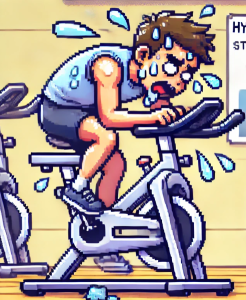
Track & Field Beats Yoga for Mental Health
What if your choice of exercise could be the difference between feeling energized or exhausted, upbeat or burned out, healthy or just… hanging on?
A new large-scale study from Lithuania tracked over 5,800 adults to find out exactly how different types of physical activity relate to 11 key health indicators—things like stress, depression, sleep, BMI, and breakfast habits. The verdict? Not all movement is created equal.
Why This Study Matters Now
We all know exercise is “good for us,” but that vague advice isn’t always motivating—especially when life is busy, stress is high, and the couch is calling. What if we had evidence that certain kinds of exercise were better at reducing stress, curbing overeating, or improving sleep?
This research offers exactly that: a health behavior report card for the 20 most popular types of exercise (like cycling, yoga, boxing, and triathlon), professional sports, and doing nothing at all.
In a world of wearable trackers and wellness trends, it’s refreshing to see real-world data guiding us toward what actually works—and who it works best for.
The Healthiest Athletes Aren’t Always Pros
Researchers divided participants into three groups: professional athletes, people who exercised regularly (the E-20 group), and those who didn’t exercise at all. They then looked at how each group scored across health areas like:
- Depressed mood
- Stress
- Body Mass Index (BMI)
- Sedentary behavior
- Sleep quality
- Smoking and alcohol use
- Eating habits (like breakfast and overeating)
The biggest surprise? While professional athletes had the best sleep and lowest BMI, they weren’t the happiest. Regular exercisers who did sports like track-and-field, cycling, and boxing had lower rates of stress and depressed mood than the pros.
“People often think professional athletes are the healthiest,” said the researchers. “But emotional health may benefit more from recreational activities done during leisure time.”
Your Workout Type Matters—A Lot
Let’s get to the juicy part: Which workouts ranked highest overall?
For Women:
🏅 Track-and-field and High-Intensity Training (HIT) scored best for stress, mood, and physical health.
🥈Dance and running also made the top three.
🚫 Yoga and volleyball were surprisingly not associated with lower stress or better mood.
For Men:
🥇 Triathlon and track-and-field took the top spots.
🥈Boxing and bodybuilding followed closely.
😮 Yoga ranked lowest for mood and energy.
In fact, men in the yoga group reported some of the highest rates of stress and depressed mood—bucking the popular image of yoga as a universal stress-buster.
The Breakfast Club: Who Eats Best?
HIT women and track-and-field men were the most likely to eat breakfast regularly, a marker of stable routines and healthier eating overall.
The biggest overeaters? Women in cycling and aerobics, and men in wrestling and yoga.
And when it came to avoiding smoking and alcohol? Track-and-field again topped the charts, especially for women. In men, gym-goers smoked less, and powerlifters drank the least.
A Day in the Life: Movement, Sleep, and Screens
This study didn’t just ask about workouts. It analyzed full 24-hour energy use: sleep, sitting, light activity, and more.
- Track-and-field participants—both men and women—slept more, moved more, and sat less than any other group.
- Martial artists and HIT fans, on the other hand, logged more sedentary time and had shorter sleep durations.
In short: consistency beats intensity. The healthiest people weren’t necessarily the most extreme athletes—they were those who integrated moderate-to-vigorous movement into their daily lives and routines.
What Does This Mean for You?
Whether you’re a casual jogger, a yoga devotee, or just someone thinking about getting off the couch, here’s what this study suggests:
- Doing something is better than nothing. People who exercised—any amount, in any way—scored better across nearly all health indicators than those who didn’t.
- Exercise during leisure time matters most. You don’t have to be a pro. Just make movement a meaningful, enjoyable part of your week.
- Track-and-field-style workouts (like sprinting, jumping, interval training) offer the biggest total health boost, especially for mood and BMI.
- Tailor your activity. Some exercises may be better suited to your stress level, sleep habits, or body composition goals.
What’s Next in Research?
This study was cross-sectional, meaning we can’t say if exercise causes health benefits or if healthier people simply exercise more. But it gives a compelling snapshot of how specific workouts align with real-life well-being.
Future studies might explore age differences, how long-term participation affects outcomes, or what happens when people switch sports.
Still, the takeaway is clear: Your choice of movement can shape your mental and physical health—sometimes in surprising ways.
Join the Conversation
🧠 Which type of exercise gives you the biggest mental health boost?
🏃 What’s one workout you’ve been meaning to try but haven’t yet?
📉 Do these findings shift how you think about “being healthy”?
Let us know in the comments—or better yet, go outside and try some track sprints.



